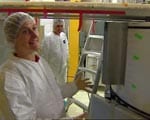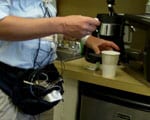Live Chat: Science at the Olympics
Book a live interview

To book a live or taped interview with Peter Weyand in the SMU News Broadcast Studio call SMU News at 214-768-7650 or email news@smu.edu. |
Related links
- Peter Weyand
- Journal of Applied Physiology: “The biological limits to running speed are imposed from the ground up”
- Part 1: Clarifications of the history of the case
- Part 2: The science of Oscar Pistorius’ advantage
- Annette Caldwell Simmons School of Education & Human Development
More SMU Research news
Science magazine hosted a live chat with scientific experts about any competitive advantage provided by the cutting-edge, light-weight prosthetic legs of double-amputee South African runner Oscar Pistorius, the first amputee to compete in the Olympics.
The July 18 chat “Science at the Olympics” included SMU’s Peter Weyand, an expert in human locomotion.
Controversy has swirled around Pistorius as the debate continues over the scientific advantage he enjoys as a result of his high-tech, carbon fiber artificial legs. Weyand helped lead a team of scientists who are experts in biomechanics and physiology in conducting experiments on Pistorius and the mechanics of his racing ability.
Weyand is widely quoted in the press for his expertise on human speed. He is an SMU associate professor of applied physiology and biomechanics in the Annette Caldwell Simmons School of Education & Human Development.
EXCERPT:
By Nicholas St. Fleur
Science
Every Olympic season brings new scientific innovations that help athletes earn the gold and break world records. This year’s London Games, for example, will see South African double-amputee runner Oscar Pistorius make his debut on the 400-meter-dash while donning cutting edge, lightweight prosthetics. At the same time, Olympic officials will be cracking down on another innovation: new drugs that help athletes outcompete their rivals. Do prosthetic limbs offer an unfair advantage? What is being done to keep steroids and blood doping out of the games? And has scientific innovation become as important a player in the Olympics as the athletes themselves?
Hello everyone and welcome to ScienceLive! As you know, the Olympics are just a week away, and today we’re discussing the role of science in the London Olympics from blood dopers to the ‘Blade Runner’ and whether scientific innovation has become as important a player in the games as the athletes themselves.
Fleur: With us today is Don Catlin, a sports drug expert and professor emeritus at UCLA who founded the UCLA Olympic sport testing laboratory which is a national testing site for performance enhancing drugs in athletes.
To comment on the use of prosthetics in this year’s games is Peter Weyand, an Associate Professor of Applied Physiology and Biomechanics at Southern Methodist University in Dallas, Texas, who has studied the mechanics, physiology and locomotor performance behind running for decades.
Also on the biomechanics scene is J.L. McNitt-Gray, a Professor in the Departments of Biological Sciences and Biomedical Engineering at the University of Southern California, who studies the dynamics of human movement.
Let’s begin with a question for Peter and J.L. South African 400-meter-dash runner Oscar Pistorius will become the first amputee to compete against able-bodied athletes. What allows his prosthetic to help him keep up with the other athletes?
Weyand: Modern lower limb prostheses, in many respects, mimic the mechanical function of a biological leg during running. Two properties of the prostheses are particularly important: weight and springiness.
Excellent data is available to show that for single leg amputees, these limbs almost restore normal function, for double lower limb amputees, they enhance it due to the proerties above.
Single leg amputees are limited by their biological legs. Double limb amputees can fully exploit the mechanical properties of the prostheses for sprint running performance.
Weyand was asked whether the competitive advantage might prompt athletes to voluntarily have their legs amputated in order to have prosthetics.
Weyand: How realistic a voluntary amputation scenario might be is difficult to project at this time. One limitedly recognized aspect of the Pistorius controversy is that reaping the competitve advantages of lower limb prostheses requires having and using two of them. The primary reason Oscar Pistorius is so much faster than other amputees who use the same blades is because double lower limb amputees are quite rare.
Weyand was asked about the need for standardized prosthetics for the Olympics:
Weyand: The standardization issue is a critical one that raises difficult questions for the governing bodies of sport that are not unlike the performance enhancing drug issues in some ways. As science and technology progress, more and more powerful the avenues of performance enhancement become available and the lines between “natural” and unenhanced vs. enhanced become increasingly blurred.
Reasonable guidelines might be possible for prostheses, but the task of evaluating competitive fairness would be resource-intensive and probably never perfect. (…)
SMU is a nationally ranked private university in Dallas founded 100 years ago. Today, SMU enrolls nearly 11,000 students who benefit from the academic opportunities and international reach of seven degree-granting schools. For more information see www.smu.edu.
SMU has an uplink facility located on campus for live TV, radio, or online interviews. To speak with an SMU expert or book an SMU guest in the studio, call SMU News & Communications at 214-768-7650.
By Margaret Allen
Senior research writer, SMU Public Affairs
View Archive →
 Observed! SMU’s LHC physicists confirm Higgs ‘God particle’
Observed! SMU’s LHC physicists confirm Higgs ‘God particle’ DOE Award: advancing SMU’s link to the God particle
DOE Award: advancing SMU’s link to the God particle Ancient tree-ring records from southwest U.S. suggest today’s megafires are truly unusual
Ancient tree-ring records from southwest U.S. suggest today’s megafires are truly unusual Human diabetes has new research tool: Overfed fruit flies that develop insulin resistance
Human diabetes has new research tool: Overfed fruit flies that develop insulin resistance Modeling the human protein in search of cancer treatment: SMU Researcher Q&A
Modeling the human protein in search of cancer treatment: SMU Researcher Q&A Middle school boys who are reluctant readers value reading more after using e-readers
Middle school boys who are reluctant readers value reading more after using e-readers Dark matter search may turn up evidence of WIMPS: SMU Researcher Q&A
Dark matter search may turn up evidence of WIMPS: SMU Researcher Q&A Unconventional geothermal techniques a potential game changer for U.S. energy policy
Unconventional geothermal techniques a potential game changer for U.S. energy policy Study: Nearly two-thirds of EU citizens are marginalized by English-language dominance
Study: Nearly two-thirds of EU citizens are marginalized by English-language dominance Public health insurance provides insured infants better, less costly care than private plans
Public health insurance provides insured infants better, less costly care than private plans